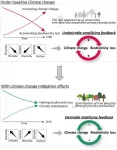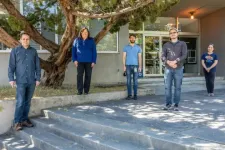(Press-News.org) Difficulty sleeping, sleep apnea and narcolepsy are among a range of sleep disorders that thousands of Danes suffer from. Furthermore, it is estimated that sleep apnea is undiagnosed in as many as 200,000 Danes.
In a new study, researchers from the University of Copenhagen's Department of Computer Science have collaborated with the Danish Center for Sleep Medicine at the danish hospital Rigshospitalet to develop an artificial intelligence algorithm that can improve diagnoses, treatments, and our overall understanding of sleep disorders.
"The algorithm is extraordinarily precise. We completed various tests in which its performance rivaled that of the best doctors in the field, worldwide," states Mathias Perslev, a PhD at the Department of Computer Science and lead author of the study, recently published in the journal npj Digital Medicine (link).
Can support doctors in their treatments
Today's sleep disorder examinations typically begin with admittance to a sleep clinic. Here, a person's night sleep is monitored using various measuring instruments. A specialist in sleep disorders then reviews the 7-8 hours of measurements from the patient's overnight sleep.
The doctor manually divides these 7-8 hours of sleep into 30-second intervals, all of which must be categorized into different sleep phases, such as REM (rapid eye movement) sleep, light sleep, deep sleep, etc. It is a time-consuming job that the algorithm can perform in seconds.
"This project has allowed us to prove that these measurements can be very safely made using machine learning - which has great significance. By saving many hours of work, many more patients can be assessed and diagnosed effectively," explains Poul Jennum, professor of neurophysiology and Head of the Danish Center for Sleep Medicine.
In the Capital Region of Denmark alone, more than 4,000 polysomnography tests - known as PSG or sleep studies - are conducted annually on patients with sleep apnea and more complicated sleeping disorders. It takes 1.5-3 hours for a doctor to analyze a PSG study. Thus, in the Capital Region of Denmark alone, between 6,000 and 12,000 medical hours could be freed up by deploying the new algorithm.
The algorithm functions across sleep clinics and patient groups
By collecting data from a variety of sources, the researchers behind the algorithm have been able to ensure optimal functionality. In all, 20,000 nights of sleep from the United States and a host of European countries have been collected and used to train the algorithm.
"We have collected sleep data from across continents, sleep clinics and patient groups. The fact that the algorithm works well under such diverse conditions is a breakthrough," explains Mathias Perslev and Christian Igel, who led the project on the computer science side, adding:
"Achieving this kind of generalization is one of the greatest challenges in medical data analysis."
They hope that the algorithm will serve to help doctors and researchers around the world to learn more about sleep disorders in the future. The sleep analysis software is freely available at sleep.ai.ku.dk and can be used by anyone, anywhere - including places where there isn't a sleep clinic around the corner.
"Just a few measurements taken by common clinical instruments are required for this algorithm. So, use of this software could be particularly relevant in developing countries where one may not have access to the latest equipment or an expert," says Mathias Perslev.
The researchers are now working with Danish physicians to get the software and algorithm approved for clinical use.
INFORMATION:
When sailing along on the seas and you suddenly spot a porpoise's fin in the distance, chances are that you have only encountered a single animal. Porpoises are most often seen alone, but new research now suggests that they also roam in groups - and even enter into a sophisticated collaboration when hunting.
The way they collaborate surprises us, because the common perception among biologists is that porpoises roam and hunt alone, says Associate Professor Magnus Wahlberg, who is an expert in marine mammals and heads the Marine Biological Research Centre at the University of Southern Denmark (SDU).
Drone footage has revealed group hunting among porpoises coming together to hunt schools of fish.
The research team has recorded almost 44 hours of drone footage from the waters around ...
Men who suffer sensory loss, particularly hearing loss, are more likely to be physically inactive and obese than women, according to a new study published in the European Journal of Public Health.
Researchers analysed data from more than 23,000 Spanish adults, and examined associations with physical inactivity and obesity in people with vision and hearing loss, and explored differences between men and women.
Results suggest inactive people with hearing loss were 1.78 times more likely to be obese compared to those who did not have any hearing loss. In people who had difficulty seeing, the odds ratio is slightly smaller, with a likelihood ...
Systematic literature review provides evidence base for new therapeutic avenues in vasculitis
Researchers have reviewed all clinical trials of targeted drugs used in the treatment of vasculitis. With this, they propose a completely mechanistic categorisation of these diseases, which may in time provide better treatment.
Diseases which cause inflammation of the blood vessels are presently categorised according to the size of the blood vessels involved. But it would make more sense - and ultimately end with better treatment - if the diseases were categorised based on the causes of the inflammation.
This is shown by a systematic literature review of clinical trials in vasculitis, which researchers from Aarhus ...
Astrophysicists from the University of Bath have developed a new method for pinpointing the whereabouts of extremely rare extragalactic objects. They hope their technique for finding 'changing-look quasars' will take scientists one step closer to unravelling one of greatest mysteries of the universe - how supermassive black holes grow. Quasars are believed to be responsible for regulating the growth of supermassive black holes and their host galaxies.
A quasar is a region of spectacular luminosity at the centre of a galaxy, powered by a supermassive black hole - the largest type of black hole, with a mass that exceeds that of our sun by millions or billions. There is a supermassive black hole ...
When it comes to climate change, policymakers may fail to see the trees for the forest. Turns out that the trees may be the answer after all, according to a study published by authors from more than seven countries on June 3rd in Nature Climate Change.
"Climate change and biodiversity loss are two major environmental challenges," said paper author Akira S. Mori, professor at Yokohama National University. "But the vast majority of attention has been paid to one unidirectional relationship -- climate change as a cause and biodiversity loss as a consequence."
Mori and his co-authors argue that climate change and species ...
Tuesday, 8 June 2021: A study by RCSI indicates that exercise is probably the most effective short-term treatment for depression in people with coronary heart disease, when compared to antidepressants and psychotherapy or more complex care.
The study, led by researchers at RCSI University of Medicine and Health Sciences, is published in the June edition of Psychosomatic Medicine.
This is the first systematic review to compare treatments for depression in those with coronary disease and the findings provides valuable clinical information to help doctors determine the best treatment plan for patients.
The researchers reviewed treatment trials which investigated antidepressants, psychotherapy, ...
Around the globe, software-intensive organisations shift from plan-based development processes to Agile ones, intending to focus more on team interaction, better products, customers' needs, and readiness to change.
But how do these organisations succeed with large-scale Agile software transformations - and how do the success factors relate? This has been discussed in the scientific community for several years. Now, Associate Professor Daniel Russo from Department of Computer Science, Aalborg University presents a long-term study, which sheds even more light on the ...
Rising unemployment, inadequate benefits and low paid work are the main causes of poverty and destitution in Stoke-on-Trent according to the findings of a new study.
The research carried out by Staffordshire University and Citizens Advice Staffordshire North & Stoke-on-Trent, and funded through Research England's Strategic Priorities Fund, aims to understand the impact COVID-19 is having on residents in the city.
The report includes case studies of people who have turned to Citizens Advice and Alice Charity's Foodbank after finding themselves unable to work through the pandemic and facing increasing debt or struggling to claim benefits.
Post ...
Lanthanides are rare-earth heavy metals with useful magnetic properties and a knack for emitting light. Researchers had long assumed that lanthanides' toxicity risk was low and therefore safe to implement in a number of high-tech breakthroughs we now take for granted: from OLEDs (organic light-emitting displays)¬¬ to medical MRIs and even hybrid vehicles.
In recent years, however, some scientists have questioned lanthanides' safety. In matters concerning health care, for example, some MRI patients have attributed a litany of side effects, including ...
Most fish rely on water to feed, using suction to capture their prey. A new study, however, shows that snowflake morays can grab and swallow prey on land without water thanks to an extra set of jaws in their throats.
After a moray eel captures prey with its first set of jaws, a second set of "pharyngeal jaws" then reaches out to grasp the struggling prey and pull it down into the moray's throat. Rita Mehta, an associate professor of ecology and evolutionary biology at UC Santa Cruz, first described this astonishing feeding mechanism in a 2007 Nature paper.
The new study, published June 7 in the Journal of Experimental Biology, shows that these pharyngeal jaws enable ...



